-

大班科学《什么东西能导电》说课稿
二、课堂实录:第一个实验是:什么东西能导电?我请请小朋友来玩“会发光的小灯泡”这个游戏,不过这次的材料和活动区使用的材料有点不同:不光有铜丝、铁丝,还有塑料线、毛线、纸绳,请小朋友自己试验一下,哪种材料能使小灯泡亮起来,并把你的试验结果计下来。小朋友听到我的这个要求,小朋友马上行动起来,每个小朋友拿了一张记录纸做起实验来,那认真劲还真象一个小科学家,有的小朋友还问我:“老师,为什么还有毛线呢?”实验后小朋友得出结论:金属类的材料能导电,所以小灯泡就能亮起来,塑料、毛线、纸等东西不能导电。我们平时见到的电线都是用金属类的材料来做的。接下来是第二个实验:那根电线能导电?请小朋友拿一根电线,看看它们能不能使小灯泡发光?这时小朋友选择的电线可不是一样的了,有两边露出铜线的、有一边露出铜线的、有两边都没有铜线的,经过小朋友自己的操作,有的小朋友能使小灯泡亮起来,有的小朋友选择的电线就不能使小灯泡亮起来,于是我就针对这一现象请小朋友进行讨论:为什么有的电线也不能使小灯泡发光呢?并得出结论:电线的外面包了一层塑料的外衣,塑料是不导电的,有的电线把两边的塑料去掉了露出了里面的铁丝,所以就能导电,小灯泡才能发光,有的电线两边的塑料没有去掉,塑料是不导电的,所以小灯泡就不会发光了。紧接着我又进行提问引出讨论:为什么要用塑料把铁丝包住呢?电既然是很危险的,为什么人们还要去使用它?经过了一些实际操作和讨论,小朋友们对于电的特性已经有了一些了解,然后我拿出为小朋友准备的一些材料请小朋友来当“小小工程师”,用电线、电池做一个小手电筒,孩子们可高兴了,三五成群的组成一组,一边制作一边争论,因为别的小朋友没有采纳小纽纽的建议,小纽纽还着急的直跺脚呢。当曾辉那组的小朋友先制作出小手电筒时,他们高兴的拍起了手庆祝自己的成功。三、课后自评:本活动有三个目标:1、知道金属类的材料能导电,塑料、纸、毛线等材料不导电。2、了解电的用途,以及安全用电常识。3、对科学小制作感兴趣。
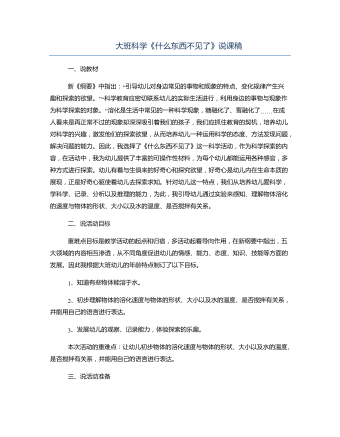
大班科学《什么东西不见了》说课稿
二、说活动目标重难点目标是教学活动的起点和归宿,多活动起着导向作用,在新纲要中指出,五大领域的内容相互渗透,从不同角度促进幼儿的情感、能力、态度、知识、技能等方面的发展。因此我根据大班幼儿的年龄特点制订了以下目标。1、知道有些物体能溶于水。2、初步理解物体的溶化速度与物体的形状、大小以及水的温度、是否搅拌有关系,并能用自己的语言进行表达。3、发展幼儿的观察、记录能力,体验探索的乐趣。本次活动的重难点:让幼儿初步物体的溶化速度与物体的形状、大小以及水的温度、是否搅拌有关系,并能用自己的语言进行表达。三、说活动准备1、玻璃杯多个、碟子2、食盐、面糖、冰糖、糖块、木块、玻璃珠等3、记录表、热水、凉水、笔若干四、说教学法教法:在活动中,教师要心中有目标,眼中有幼儿,时时有教育,让幼儿真正成为学习的主体,正如新纲要中所说的:“教师应成为学习活动的支持者、合作者、引导者”因此,本次活动我采用了以下方法:1、教师以饱满的热情参与活动,用激情感染幼儿,对幼儿起示范带动作用,引起幼儿活动的积极性。2、启发提问法:教师的提问要具有启发性,引起幼儿的思考3、观察指导法:针对科学探索活动的随机性,以及幼儿的建构过程,采取观察指导法是比较合适的,教师通过敏锐的观察,有针对性的进行、指导。
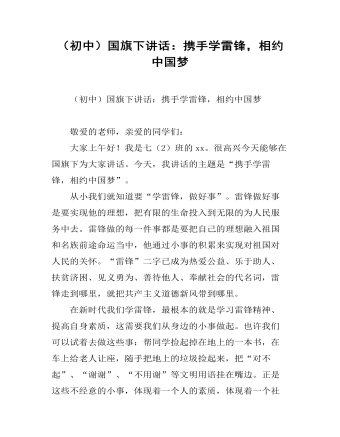
(初中)国旗下讲话:携手学雷锋,相约中国梦
从小我们就知道要“学雷锋,做好事”。雷锋做好事是要实现他的理想,把有限的生命投入到无限的为人民服务中去。雷锋做的每一件事都是要把自己的理想融入祖国和名族前途命运当中,他通过小事的积累来实现对祖国对人民的关怀。“雷锋”二字已成为热爱公益、乐于助人、扶贫济困、见义勇为、善待他人、奉献社会的代名词,雷锋走到哪里,就把共产主义道德新风带到哪里。在新时代我们学雷锋,最根本的就是学习雷锋精神、提高自身素质,这需要我们从身边的小事做起。也许我们可以试着去做这些事:帮同学捡起掉在地上的一本书,在车上给老人让座,随手把地上的垃圾捡起来,把“对不起”、“谢谢”、“不用谢”等文明用语挂在嘴边。正是这些不经意的小事,体现着一个人的素质,体现着一个社会的文明程度。
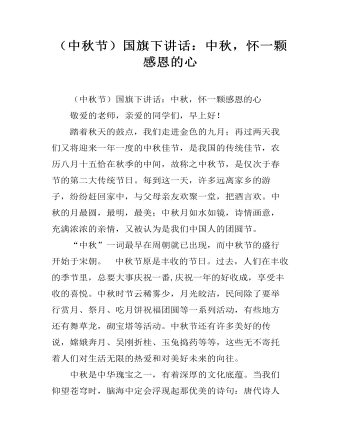
(中秋节)国旗下讲话:中秋,怀一颗感恩的心
踏着秋天的鼓点,我们走进金色的九月;再过两天我们又将迎来一年一度的中秋佳节,是我国的传统佳节,农历八月十五恰在秋季的中间,故称之中秋节,是仅次于春节的第二大传统节日。每到这一天,许多远离家乡的游子,纷纷赶回家中,与父母亲友欢聚一堂,把酒言欢。中秋的月最圆,最明,最美;中秋月如水如镜,诗情画意,充满浓浓的亲情,又被认为是我们中国人的团圆节。“中秋”一词最早在周朝就已出现,而中秋节的盛行开始于宋朝。 中秋节原是丰收的节日。过去,人们在丰收的季节里,总要大事庆祝一番,庆祝一年的好收成,享受丰收的喜悦。中秋时节云稀雾少,月光皎洁,民间除了要举行赏月、祭月、吃月饼祝福团圆等一系列活动,有些地方还有舞草龙,砌宝塔等活动。中秋节还有许多美好的传说,嫦娥奔月、吴刚折桂、玉兔捣药等等,这些无不寄托着人们对生活无限的热爱和对美好未来的向往。
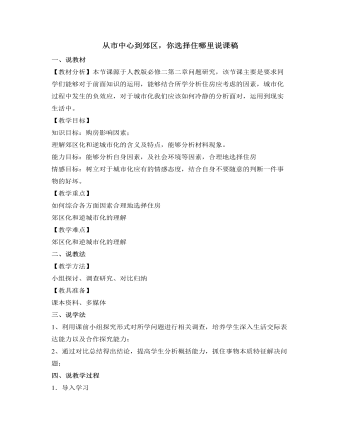
人教版高中地理必修2从市中心到郊区,你选择住哪里说课稿
课前活动:分成四组,对南京三个住房地段进行调查,新街口夫子庙、板仓、仙林,对住房居民进行问卷调查,自行设计调查问卷,分析该地段的房价要求,居民的要求,居民为何要在该地段购买住房,基础设施设置等等其它与居民购房有关的因素。◆设计意图:利用课前小组探究形式对所学问题进行相关调查,不仅让学生掌握知识了解知识来源于社会还能培养学生深入生活交际表达能力以及合作探究能力;3.问题设计同学们,不知道你们在调查过程中是否发现一个问题,郊区的房子,特别是别墅,都是些高档居所,许多有钱人的居住场所,那为什么会这样呢?伴随着城市化进程中居民都往城里挤,为什么还会有许多有钱人往郊区搬呢?这就是我们今天要研究的第二个问题:逆城市化。◆设计意图:承转过渡知识,从购房选择因素的学习过渡到郊区化的学习,同时培养学生发现问题的能力,给学生以启迪。
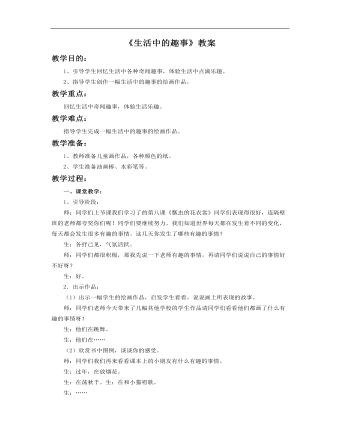
小学美术人教版一年级下册《第9课生活中的趣事》教案说课稿
一、课堂教学:1、引导阶段:师:同学们上节课我们学习了的第八课《瓢虫的花衣裳》同学们表现得很好,连隔壁班的老师都夸奖你们呢!同学们要继续努力。我们知道世界每天都在发生着不同的变化,每天都会发生很多有趣的事情。这几天你发生了哪些有趣的事情?生:各抒己见,气氛活跃。师:同学们都很积极,那我先说一下老师有趣的事情,再请同学们说说自己的事情好不好呀?
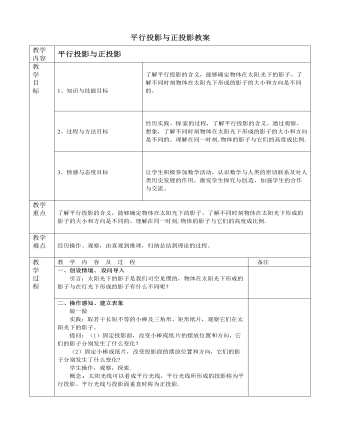
北师大初中数学九年级上册平行投影与正投影2教案
四、范例学习、理解领会例2 某校墙边有甲、乙两根木杆。已知乙木杆的高度为1.5m.(1)某一时刻甲木杆在阳光下的影子如图5-6所示,你能画出此时乙木杆的影子吗?(用线段表示影子)(2)在图中,当乙木杆移动到什么位置时,其影子刚好不落在墙上?(3)在(2)的情况下,如果测得甲、乙木杆的影子长分别为1.24m和1m,那么你能求出甲木杆的高度吗?学生画图、 实验、观察、探索。五、随堂练习课本随堂练习 学生观察、画图、合作交流。六、课堂总结本节课通过各种实践活动,促进大家对内容的理解,本课内容,要体会物体在太阳光下形成的不同影子,在操作中观察不 同时刻影子的方向和大小变化特征。在同一时刻,物体的影子与它们的高度成比 例.
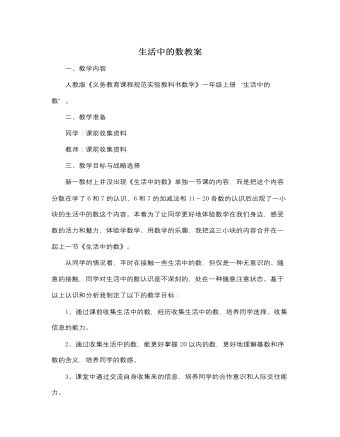
人教版新课标小学数学一年级上册生活中的数教案
六、教学反思 从这节课的实施情况看,课堂实施与原先的公开课教案是比较一致的,效果也是比较好的,主要体现于以下两点: 1、效果得益于“跳出”--跳出教材框框 刚开始备课和试教时,我打算充沛利用教材,根据教材上的内容出示幻灯片让同学说一说,但一节课下来显得很单调、信息量很少,体现不出生活中数的味道。于是我开放教材,跳出教材的框框,课前安排一个“找生活中的数”实践活动把同学放到社会生活之林中去,让他们先找些“野食”吃。这样,课前在准备过程当中积累的素材多了,同学的学习效益大大提高了。同学在丰富多彩的实际生活中自由自在地采撷自身感兴趣的“果子”,他们采来的“果子”是绚丽多姿的,然后回到课堂交流,共享到了“果子”的丰富,起到“以一当数十”的作用。 这个“跳出”战略,体现了现代科学“系统论”的理论。系统论认为:系统只有开放,不时吸收外界的信息,才干使自身“有序”。

人教版新目标初中英语七年级上册How much are these pants教案
个性练习设计 阅读广告:在日常生活中,人们去买东西之前,一般要阅读广告,从广告中获取该商品的一些有用信息,包括价格、性能等。所以给学生提供有些商品的广告或让学生去商店去阅读一些商品的广告,从中获取商品的价格,即可以锻炼学生的阅读能力,又能提高实践能力。 Self Check 教学内容 Self Check(教材P42) 教学目标 知识与能力 复习词汇pant,sock,T-shirt,sweater,shoes,color,black,white,red,green,blue,big,short,long,数字10--31; 学习词汇Zig Zag,clothes,shop,yellow,ask,which;学会谈论服装的价格、颜色、大小和长短;学会填写价格标签。 过程与方法 运用Summarizing和Classifying的学习策略。在复习教学中,运用听写、绘画、互相询问调查与检测等手段,促使学生不断地使用所学内容,从而提高他们灵活运用知识的能力。 情感态度价值观 该部分学习内容主要是复习谈论服装的价格和颜色以及对服装的喜好,能引起学生的共鸣;通过购物的对话练习教学生学会购物时使用的礼貌用语和如何感谢人。

人教版新目标初中英语七年级下册How was your weekend教案2篇
Teaching Goal:1. General aims:Talk about recent past events2. Particular aims:A. Language Focus.Talk about recent past events and think of the past events.B. Language goalsHow was….?It was …What did …do over the weekend?C. Language structures:(1). How was your weekend? I was great. Pay attention to no form.(2). What did you do over the weekend? I played soccer. We went to the beach.D. Useful words and phrases:Words: was, did, went, beach, over, project, test, wasn’t, false, number, geography, spend, week, most, mixture, their, had, little, cook, read, saw, change, everyone, sit, sat, no, anythingPhrases: did one’s homework, played soccer, cleaned my room, went to the beach, played tennis, went to the movies, on Saturday morning, over the weekend, cook … for, what about, do some reading, have a party, talk show, go shoppingE. Grammar language:Present simple past tenseRegular and irregular verbsF. Learning strategies:Tour and holidaysG. Interdiscipinary:H. Emotion and manner:Teaching time: 5 periodsTeaching procedures:Period One教学步骤、时间 教师活动 学生活动 媒体应用Step 1Free talk 3’ Ask some questions like:Who’s on duty today?What’s the weather like? Answer and talk about something.让同学们回答下列问题1. Do you like weekend? (Let some students answer)It takes them three minutes to talk about the question.2. Why do you like weekend? (let the students answer) Most of the students like the weekend此时教师用汉语问:“在周末期间问你干了什么?这句话用英语这么回答?Let the students guess.At last the teacher give them right answer3. What did you do over the weekend?(板书、学习)

人教版新目标初中英语七年级下册What does he look like教案3篇
所需要用到的句子:Who is that?That is Jack. I like him.Why do you like him?I like him because he is interesting.Task 4: 设计理想中的人类Step one: 设计理想中的人类的外貌。把全班同学分成若干小组,学生可以边说边在纸上画出他们的模样。Step two: 设计理想中人类的性格。学生们可以把那些能描述性格的单词写在图画的旁边。Step three: 每组选出一名同学,其他同组同学提问,他作简单回答,并说明原因。所需用到的句子:What does he or she look like?He or she ...What is he or she like?He or she is ...Why?Because ...Task 5: 挑战性活动调查性格是天生的还是后天形成的,让每个同学回家去调查一下自己成长过程中性格是否有变化,具体是怎样的,为什么会这样? Teaching Aims:1. Enable students to have a general understanding of how to talk about people's physical appearance.2. Enable students to tackle some essential vocabularies and patterns about describing people. Provide them with necessary skills and methods.3. Create various chances for students to describe the persons they're familiar with, such as classmates, family members, teachers, idols, etc.

人教版新目标初中英语七年级上册What’s this in English教案
一、知识和能力目标本单元的核心教学内容是“认物”。用英语确认周围的常见事物比较符合英语初学者的实际情况。通过本单元教学,使学生运用所学句型,去熟悉周围事物的名称;教学生学会在实际生活中如何确认事物。通过辨认物体,学生学到一些生词,并巩固所学句型。二、过程和方法目标教师要尽量使学生对课文中出现的句型能够熟练上口,这样,学生才能顺利开展比较灵活的对话。教师可以用手势,表情,动作等示意,帮助学生听懂课堂教学内容,但在实际操作中应尽量避免“明知故问”的倾向,应该采用应用性原则;如:遮盖物品、显露局部、辨认物体、完形识别、图形辨认等方法。三、情感态度和价值观目标目标在学生学习过程中的作用至关重要,教师要帮助他们建立起一个切合自己实际的目标,通过渐进的学习以及一点一滴的进步,使他们逐步建立起成功感。成功越多,自信心就越强。

人教版新目标初中英语七年级下册I ’d like some noodles教案
教学过程Step 1: warming-up Sing a song---------“food and drink” Step 2: Revision1 Dictation2 Revise: What kind of noodles would you like?I’d like …What size bowl of noodles would you like?I’d like…Step 3: Presentation1 show pictures of food, ask students say the words.2 Students read the newspaper ad in 3a. Fill in blanks with words in the box. Then read the ad together, the teacher explains some difficult language points.3 Check the answers Step 4 PracticeAsk students to finish 3b in the same way according to 3a. Students read the short passage and fill in the blanks .At last, check the answers.Step 5 productionAsk students to write their own ad for dumplings, noodles, drinks, and other foods they know. Then ask students to read their partner’s ad. Then order food and drink from their partner.Step 6 Home workGroup work – make an ad about “food and drink”

人教版新目标初中英语七年级下册Where is your pen pal from教案
2.1Match the country with the language.Step II Reading3a? let the students read the letter fast and answer the questions.? Let the students ask more questions about the letter as possible as the can.Step III Writing3b.Step IV. Pairwork2cStep V Listening2a, 2bStep V. HomeworkExercises book(1) P3Exercises book (2) P3Period FourStep I . Dictate the words and sentences in Unit1.Step II. Self-checkStep III. Check the answers for Exercises book in the unit.Step IV. Home workRevise and preparation for unit 2.教学反思:通过本单元的学习,学生基本可以谈论人们的国籍,居住城市及其所说的语言,通过书信方式去介绍自己并寻找笔友。但在涉及到国外的一些城市时,学生对这方面的知识相对欠缺,能介绍的城市并不多,也反应出学生课前预习不充分,这跟学生学习条件也有关,大多数学生无法通过网络获取所需信息。因此,在以后的教学中要多指导学生通过计算机网络获取信息,拓宽知识面。

人教版新目标初中英语七年级下册Where did you go on vacation教案
句型: Where did you go on vacation? I went to summer camp.Did she go to Central Park?Yes,she did.No, she didn’t语法:一般过去时特殊疑问句、一般疑问句及肯、否定回答。课时安排4课时第一课时:Section A:la,1b,lc,2a,2b,2c 第二课时:Section A:3a,3b,4第三课时:Section B:1,2a,2b,2c第四课时:Section B:3a,3b,3c,4 and Self Check第一课时教学目标掌握描写假期生活的形容词。假期里自己所做事情的简单表达。谈论假期做的事情及当时情况。谈论假期时旅游的天气,旅游者以及食物等。教学过程一、导入播放一首英文歌曲:Let’s travel 说明:通过让学生听节奏欢快迪斯尼英语歌曲Let’s travel.引入本节课谈论的话题vacation and travel. 让歌曲使学生的思维活跃,增强课堂气氛,激发学生提高学习英语的兴趣。T:How is the trip ?Ss : It’s pretty good/ happy/exciting /relaxing/busy/dangerous/ fantastic说明:这个问题是为了操练形容词。建议让多个Ss作答。鼓励他们用不同的形容词。上述个别形容词本应在第二课时中出现,但可以在warming-up中第一次非正式出现。这些形容词也可在老师的评价语中适时出现,以加深学生对词汇的印象。

人教版新目标初中英语八年级上册Can you come to my party教案3篇
Step 3 (3b)First, tell the students when we talk about our future plans, we often use: I’m+verb+ing When we talk about what we must do, we use have to. Ask the students to fill in the blanks in 3b. The answers are: shopping, go to see, a test, I’m going, my family. Step 4 (3c)Let the students write an e-mail message to a friend. Say why you can’t visit next. Before the exercise, ask the students to give some possible answers and write them on the blackboard. So the students will feel easy to finish the writing exercise. After they finish it, Let them to correct it in groups first. Each group chooses theirs best one to read in front of the whole class. Step 5 ( planning a party )First read the conversation in the box together. Then ask the students to turn to page 88.Write down everything you have to do next week. Write in all the things you have to do . Ask the students to look at the list. Ask them “What day are you free?” This is when you can have your party. Step 6 (Self check 1 )Let the students to fill in the blanks with the words given. Change the forms of the words if possible. Then make their own sentences. The answers are: visit, playing, have to, study, comeStep 7 (Self check 2)Imagine you are Marie. Read the information and look at your schedule. Write replies to the invitation.

人教版新目标初中英语八年级上册How was your school trip教案2篇
“Go for it!” is based on “Task-Based Language Teaching”. It adheres to “The authenticity principle”, “The form-function principle”, “The task dependency principle” and “The principle of learning by doing”. These principles all accord with the demands of curriculum focus.In and of Grade Seven (II), “Go for it!”, students have learned “The Simple Past Tense”. And it appears again in of Grade Eight (I). teaches students more about how to talk about events in the past. In addition, it gives affirmative and negative statements in the past tense, such as the sentence patterns “Did you see …?” “Were there …?” “Did you go …?” As the first part of Unit 8, Section A opens with a picture presenting the last school trip in the aquarium and continues with several step-by-step practice activities, which are all good for students to master “The Simple Past Tense”. Doing well in Section A will help students integrate the new target language with that in Section B. Thus, they can describe the events in the past freely and foster their own ability of reflecting and practicing. II. Teaching ObjectivesTeaching objective is the beginning and aim of teaching activities. According to the overall goal of the English elementary course--- improve students' synthetic ability of language application, which should be based on the development of students’ “Language knowledge”, “Language skills”, “Character building”, “Learning strategies” and “Cross-cultural awareness”. The teaching objectives are described as follows(I). Knowledge objectivesi. Master the simple past tense of regular and irregular verbsii. Recite the new words and expressions about the last school trip in the aquarium, including their pronunciation and intonation

人教版新目标初中英语八年级上册How do you get to school教案2篇
Step Ⅶ Role play ( Work on 1b)1. First ask two students to read the dialogue to the class.Sa: How do you get to school?Sb: Well, I ride my bike to the subway station. Then I take the subway.2. Now work with a partner.Suppose you use two kinds of transportation to get to school \Hangzhou\Beijing... (bus, train, subway, walking, bike, etc.) Tell how you get there. You may use the phrases in 1a.3. Then ask different pairs of students to present their conversations to the class.Step ⅧListening1. Work on 2a(1) First ask students to read the list of information that Thomas wants to know.…where Nina lives.…how far from school she lives.…how long it takes to get to school.…how she gets to school.…what she thinks of the transportation.(2) Tell students what transportation and bus stop mean.bus stop 汽车站 transportation n. 运送;运输Then tell students we'll hear a recording. Please put a checkmark in front of each thing that Thomas wants to know.(3) Now play the recording for students.( Have students pay attention to the sample answer.) (4) Then correct the answers.

人教版新目标初中英语八年级上册I’m going to be a basketball player教案3篇
教学目标1.知识目标:(1)学习What are you going to be when you grow up?/How are you going to do that?句式。(2)学会用英语描述有关职业的表达法。2.能力目标:(1)能够谈论为实现理想所做出的打算和安排。(2)能够谈论未来自己与他人理想的职业及原因。(3)能用英语描述课余时间的活动安排,最终具备表达综合信息的能力。3.情感目标:新学期到来之际,让他们在学习、体育、饮食、特长、读书等方面制定计划,教育学生合理安排自己的课外生活,思考自己的理想职业及适合自己的职业。教学重点、难点本单元的重点为“be going to”表将来,want to be, what,where, when,how引导的特殊疑问句。难点是语言目标的实现。教材分析本单元以I am going to be a basketball player为话题,共设计了三部分的内容:一、Section A该部分有4个模块。第一模块围绕Do you think these jobs are interesting?这一话题展开思维(1a)、听力(1b)、口语(1c)训练;

人教版新目标初中英语八年级下册What should I do教案2篇
说明:在帮Li Lei提建议的同时,教育学生如何学好英语。第三课时教学目标1. 语言目标:a) 词汇: Original, in style, haircut, the same as.b) 语言结构:My friend wears the same clothes and has the same haircut as I do.2. 能力目标:大多数学生能够谈论自己喜欢哪种服装,提高查找信息的能力。3. 情感目标:学会如何与朋友相处,要有自己对时尚的看法。教学重点掌握一些重要词汇。教学难点学会谈论问题,并能提出书面建议。◆教学突破首先针对Erin的问题,提出个人的建议,模仿2c部分的对话展开双人交际Pair-work;听老师诵读3a部分的信件,并找出LEFT OUT的问题所在;学生完成3b部分的内容,给Left Out提出书面的建议;学以口头形式提出自己目前存在的某个问题,讲给大家听,让同学们给自己提出一个建议,并作笔录;学生两、三个人分成一组,随意性地进行口语交际,谈论P14的第4部分的某个问题,相互交换意见。

